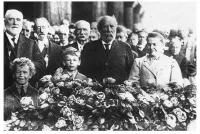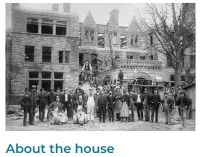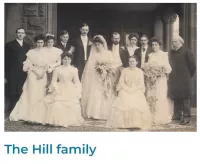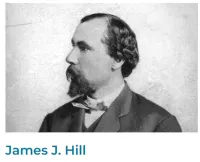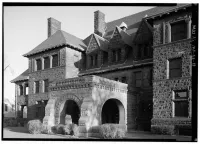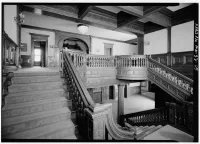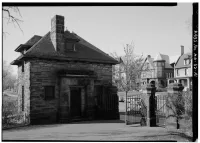Share what you know,
and discover more.
Share what you know,
and discover more.
Jun 07, 2023

-

- Charmaine Bantugan
James J. Hill House
Born in southern Ontario on September 16, 1838, to Irish immigrant parents, young Hill suffered a bow and arrow injury at age nine and lost sight in his right eye for the rest of his life. Hill's father died when the boy was 14, so Jim Hill began clerking in local shops before setting off to seek his fortune. He began his career in transportation in 1856 as a 17-year-old clerk on the St. Paul levee. Railroads After 20 years working in the shipping business on the Mississippi and Red rivers, Hill and several other investors purchased the nearly bankrupt St. Paul and Pacific Railroad in 1878. Over the next two decades, he worked relentlessly to push the line north to Canada and then west across the Rocky Mountains to the Pacific Ocean. Renamed the Great Northern Railway in 1890, it remained the "great adventure" of Hill’s life. "When we are all dead and gone," he said, "the sun will still shine, the rain will fall, and this railroad will run as usual." The 1893 depression saw the collapse of many businesses, including railroads, throughout the United States. Hill took drastic cost-saving measures to keep the Great Northern operating, but the pay cuts to railroad workers proved too much to bear. Workers went on strike that year. Surprisingly, at the end of arbitration Hill accepted most the workers’ demands. It was a notable victory for the young labor organizer Eugene Debs (and occurred a few years before the more famous Pullman strike in Chicago) and marked a significant change in workers' rights. With the return of prosperity and the wave of trust-building and consolidation in the late 1890s, Hill’s problem became one of how to retain control of his vast railroad holdings. As he bought smaller lines, his wealth and power expanded greatly. Early in 1901 he joined with J. P. Morgan to buy control of the Northern Pacific Railroad — control contested by E. H. Harriman of the Union Pacific in an epic stock market battle in May 1901. On November 1, 1901, Hill, Morgan, and Harriman announced the formation of the Northern Securities Company, a holding company formed to control the Great Northern, the Northern Pacific, and the Burlington lines. Not for the first time in Hill's career, competitors became partners. The $400-million merger consolidated all major rail lines in the northwest quarter of the nation. The move was politically unpopular and in clear violation of Minnesota statutes. It was immediately challenged in court by Governor Samuel Van Sant. In February 1902, President Theodore Roosevelt began prosecution of the Northern Securities Company under the Sherman Antitrust Act. At Hill’s insistence, the case was tried in St. Paul at the Federal Courts Building (now Landmark Center). Hill was represented by, among others, the law firm headed by Frank B. Kellogg. The case was carried to the US Supreme Court, and Northern Securities was declared to be in restraint of trade in a 5-4 decision in March 1904. It was a bitter blow to Hill, and the decision marked the role the federal government would often take in breaking up corporate monopolies in the 20th century. Other business interests Hill pursued a broad range of other business interests: coal and iron ore mining, Great Lakes and Pacific Ocean shipping, banking and finance, agriculture, and milling. In later years, he explained his economic philosophy in the book Highways of Progress and continued the campaign to convert the farmers of the Northwest to the principles of scientific agriculture, often testing breeds of cattle and strains of grain at his own farms. Marriage and family In 1864 Hill met a waitress who was working at the Merchants Hotel in St. Paul, where he often ate. Mary Theresa Mehegan, born in 1846 in New York City, was the child of Irish immigrants who settled in the frontier town of St. Paul in 1850. Hill sent Mary to finishing school in Milwaukee before their marriage in 1867 to prepare her for the impending change of stature in her life. Over the next 18 years they had 10 children: Mary, James, Louis, Clara, Katherine (who died in infancy), Charlotte, Ruth, Rachel, Gertrude, and Walter. Four of the daughters were married in the mansion, and five children later had homes on Summit Avenue. Louis succeeded his father as president of the Great Northern Railway, and lived with his family next door at 260 Summit Ave. Personal life Physically, Hill was short and barrel-chested, with a long torso and short legs. People commented on his piercing gaze and said he held their attention with his quick, animated speech, gesturing expansively and jabbing the air with a hand or finger to make his point. He was well-known for his blunt, direct manner, and many commented on his occasional flashes of humor. He was a voracious reader of nonfiction, although there are references to Hill “lustily” singing ballads based on the poems of Robert Burns. In rare moments away from work, Hill devoted himself to amassing an impressive collection of French landscape painting showcased in the two-story art gallery of his Summit Avenue mansion. He cherished summers at the family's North Oaks farm and an annual spring trip to his hunting lodge in Quebec for salmon fishing. His philanthropy included generous gifts to colleges and universities, and prompt responses to victims of disasters, such as the sinking of the Titanic, the Hinckley fire, and the San Francisco earthquake. Political contributions favored policies over party, and Hill was frequently frustrated when candidates failed to fulfill campaign promises. Death in 1916 After amassing a personal fortune estimated at $63 million and over $200 million in related assets, James J. Hill died in his Summit Avenue home on May 29, 1916, one of the wealthiest and most powerful figures of America’s Gilded Age. At the end of his life, Hill was asked by a newspaper reporter to reveal the secret of his success. Hill responded with characteristic bluntness: "Work, hard work, intelligent work, and then more work." In 1867, Mary Theresa Mehegan, the daughter of Irish immigrants, wed James Jerome Hill, a Canadian immigrant who went on to achieve incredible success. They were married for 49 years and had 10 children. A symbol of success, personal taste, and family life, the James J. Hill House recalls the powerful era of the Northwest’s “Empire Builder.” The Boston firm of Peabody, Stearns, and Furber, which was known for its impressive mansions in Newport, Rhode Island, designed a massive Richardsonian Romanesque style mansion, then very much in fashion. The final cost totaled $931,275.01 including construction, furnishings, and landscaping for the three-acre estate. Hill oversaw the planning, construction, and furnishing of the house as if it were a new branch of the railroad. He rejected stained-glass window designs by Tiffany and Company, saying they were "anything but what I want," and even replaced the architects when they ignored his orders to the stonecutters. He instructed his Boston interior design firm Irving and Casson to finish the project. Their work included a large number of custom furniture pieces on the first and second floors. The home's details When it was completed in 1891, the mansion was the largest and most expensive home in Minnesota. The house contained: 36,500 square feet on five floors 13 bathrooms 22 fireplaces 16 cut-glass chandeliers A two-story skylit art gallery An 88-foot reception hall A profusion of elaborately carved oak and mahogany woodwork A three-story pipe organ created by renowned Boston organ-maker George Hutchings Sophisticated mechanical systems throughout the mansion for central heating, gas and electric lighting, plumbing, ventilation, security, and communication Master carver John Kirchmayer, a Bavarian immigrant, was paid $1 per hour for his intricate carving of the home's grand staircase. General laborers earned $1.75 per day. The huge basement of the Hill House contained servants' quarters, a kitchen featuring a dumbwaiter (to bring food to the dining room above it), laundry, boiler room, and hand-pumped bellows for the 1,006-pipe organ in the skylit gallery above. The floor is inlaid marble. The two-story art gallery was built for Hill's magnificent art collection, consisting mainly of Barbizon School of mid-19th century landscape painters. Retractable iron grilles on the windows and doors provided security for the collection and the family's other valuable possessions. Much of the art collection was later given to the Minneapolis Institute of Art, which Hill helped found in 1915. The fourth floor features a stage in a room that could seat 200 people, a grand piano, and gymnastic equipment. The Hill children used the room as a playroom. Life at the mansion The home served as the center for the public and private lives of the Hill family for the next 30 years. Children grew up in the house, and four daughters had their weddings in the large drawing room. Newlyweds often lived in the enormous house until their own homes were completed, five of which were close by on Summit Avenue. In later years the house came alive with visits by grandchildren. Mary T. Hill kept a watchful eye over the household, including the large domestic staff of 10-12 servants. She hired maids and cooks, inspected the kitchens, and served as hostess at countless dinners and receptions. "I feel it is necessary to know just where everything is and how it is," she commented in her diary. After a visit by President William McKinley in 1899, she merely noted, "The evening passed off most pleasantly and quietly." Mrs. Hill maintained the house after her husband’s death in 1916 until her own death five years later.
James J. Hill House
Born in southern Ontario on September 16, 1838, to Irish immigrant parents, young Hill suffered a bow and arrow injury at age nine and lost sight in his right eye for the rest of his life. Hill's father died when the boy was 14, so Jim Hill began clerking in local shops before setting off to seek his fortune. He began his career in transportation in 1856 as a 17-year-old clerk on the St. Paul levee. Railroads After 20 years working in the shipping business on the Mississippi and Red rivers, Hill and several other investors purchased the nearly bankrupt St. Paul and Pacific Railroad in 1878. Over the next two decades, he worked relentlessly to push the line north to Canada and then west across the Rocky Mountains to the Pacific Ocean. Renamed the Great Northern Railway in 1890, it remained the "great adventure" of Hill’s life. "When we are all dead and gone," he said, "the sun will still shine, the rain will fall, and this railroad will run as usual." The 1893 depression saw the collapse of many businesses, including railroads, throughout the United States. Hill took drastic cost-saving measures to keep the Great Northern operating, but the pay cuts to railroad workers proved too much to bear. Workers went on strike that year. Surprisingly, at the end of arbitration Hill accepted most the workers’ demands. It was a notable victory for the young labor organizer Eugene Debs (and occurred a few years before the more famous Pullman strike in Chicago) and marked a significant change in workers' rights. With the return of prosperity and the wave of trust-building and consolidation in the late 1890s, Hill’s problem became one of how to retain control of his vast railroad holdings. As he bought smaller lines, his wealth and power expanded greatly. Early in 1901 he joined with J. P. Morgan to buy control of the Northern Pacific Railroad — control contested by E. H. Harriman of the Union Pacific in an epic stock market battle in May 1901. On November 1, 1901, Hill, Morgan, and Harriman announced the formation of the Northern Securities Company, a holding company formed to control the Great Northern, the Northern Pacific, and the Burlington lines. Not for the first time in Hill's career, competitors became partners. The $400-million merger consolidated all major rail lines in the northwest quarter of the nation. The move was politically unpopular and in clear violation of Minnesota statutes. It was immediately challenged in court by Governor Samuel Van Sant. In February 1902, President Theodore Roosevelt began prosecution of the Northern Securities Company under the Sherman Antitrust Act. At Hill’s insistence, the case was tried in St. Paul at the Federal Courts Building (now Landmark Center). Hill was represented by, among others, the law firm headed by Frank B. Kellogg. The case was carried to the US Supreme Court, and Northern Securities was declared to be in restraint of trade in a 5-4 decision in March 1904. It was a bitter blow to Hill, and the decision marked the role the federal government would often take in breaking up corporate monopolies in the 20th century. Other business interests Hill pursued a broad range of other business interests: coal and iron ore mining, Great Lakes and Pacific Ocean shipping, banking and finance, agriculture, and milling. In later years, he explained his economic philosophy in the book Highways of Progress and continued the campaign to convert the farmers of the Northwest to the principles of scientific agriculture, often testing breeds of cattle and strains of grain at his own farms. Marriage and family In 1864 Hill met a waitress who was working at the Merchants Hotel in St. Paul, where he often ate. Mary Theresa Mehegan, born in 1846 in New York City, was the child of Irish immigrants who settled in the frontier town of St. Paul in 1850. Hill sent Mary to finishing school in Milwaukee before their marriage in 1867 to prepare her for the impending change of stature in her life. Over the next 18 years they had 10 children: Mary, James, Louis, Clara, Katherine (who died in infancy), Charlotte, Ruth, Rachel, Gertrude, and Walter. Four of the daughters were married in the mansion, and five children later had homes on Summit Avenue. Louis succeeded his father as president of the Great Northern Railway, and lived with his family next door at 260 Summit Ave. Personal life Physically, Hill was short and barrel-chested, with a long torso and short legs. People commented on his piercing gaze and said he held their attention with his quick, animated speech, gesturing expansively and jabbing the air with a hand or finger to make his point. He was well-known for his blunt, direct manner, and many commented on his occasional flashes of humor. He was a voracious reader of nonfiction, although there are references to Hill “lustily” singing ballads based on the poems of Robert Burns. In rare moments away from work, Hill devoted himself to amassing an impressive collection of French landscape painting showcased in the two-story art gallery of his Summit Avenue mansion. He cherished summers at the family's North Oaks farm and an annual spring trip to his hunting lodge in Quebec for salmon fishing. His philanthropy included generous gifts to colleges and universities, and prompt responses to victims of disasters, such as the sinking of the Titanic, the Hinckley fire, and the San Francisco earthquake. Political contributions favored policies over party, and Hill was frequently frustrated when candidates failed to fulfill campaign promises. Death in 1916 After amassing a personal fortune estimated at $63 million and over $200 million in related assets, James J. Hill died in his Summit Avenue home on May 29, 1916, one of the wealthiest and most powerful figures of America’s Gilded Age. At the end of his life, Hill was asked by a newspaper reporter to reveal the secret of his success. Hill responded with characteristic bluntness: "Work, hard work, intelligent work, and then more work." In 1867, Mary Theresa Mehegan, the daughter of Irish immigrants, wed James Jerome Hill, a Canadian immigrant who went on to achieve incredible success. They were married for 49 years and had 10 children. A symbol of success, personal taste, and family life, the James J. Hill House recalls the powerful era of the Northwest’s “Empire Builder.” The Boston firm of Peabody, Stearns, and Furber, which was known for its impressive mansions in Newport, Rhode Island, designed a massive Richardsonian Romanesque style mansion, then very much in fashion. The final cost totaled $931,275.01 including construction, furnishings, and landscaping for the three-acre estate. Hill oversaw the planning, construction, and furnishing of the house as if it were a new branch of the railroad. He rejected stained-glass window designs by Tiffany and Company, saying they were "anything but what I want," and even replaced the architects when they ignored his orders to the stonecutters. He instructed his Boston interior design firm Irving and Casson to finish the project. Their work included a large number of custom furniture pieces on the first and second floors. The home's details When it was completed in 1891, the mansion was the largest and most expensive home in Minnesota. The house contained: 36,500 square feet on five floors 13 bathrooms 22 fireplaces 16 cut-glass chandeliers A two-story skylit art gallery An 88-foot reception hall A profusion of elaborately carved oak and mahogany woodwork A three-story pipe organ created by renowned Boston organ-maker George Hutchings Sophisticated mechanical systems throughout the mansion for central heating, gas and electric lighting, plumbing, ventilation, security, and communication Master carver John Kirchmayer, a Bavarian immigrant, was paid $1 per hour for his intricate carving of the home's grand staircase. General laborers earned $1.75 per day. The huge basement of the Hill House contained servants' quarters, a kitchen featuring a dumbwaiter (to bring food to the dining room above it), laundry, boiler room, and hand-pumped bellows for the 1,006-pipe organ in the skylit gallery above. The floor is inlaid marble. The two-story art gallery was built for Hill's magnificent art collection, consisting mainly of Barbizon School of mid-19th century landscape painters. Retractable iron grilles on the windows and doors provided security for the collection and the family's other valuable possessions. Much of the art collection was later given to the Minneapolis Institute of Art, which Hill helped found in 1915. The fourth floor features a stage in a room that could seat 200 people, a grand piano, and gymnastic equipment. The Hill children used the room as a playroom. Life at the mansion The home served as the center for the public and private lives of the Hill family for the next 30 years. Children grew up in the house, and four daughters had their weddings in the large drawing room. Newlyweds often lived in the enormous house until their own homes were completed, five of which were close by on Summit Avenue. In later years the house came alive with visits by grandchildren. Mary T. Hill kept a watchful eye over the household, including the large domestic staff of 10-12 servants. She hired maids and cooks, inspected the kitchens, and served as hostess at countless dinners and receptions. "I feel it is necessary to know just where everything is and how it is," she commented in her diary. After a visit by President William McKinley in 1899, she merely noted, "The evening passed off most pleasantly and quietly." Mrs. Hill maintained the house after her husband’s death in 1916 until her own death five years later.
Jun 07, 2023
James J. Hill House
Born in southern Ontario on September 16, 1838, to Irish immigrant parents, young Hill suffered a bow and arrow injury at age nine and lost sight in his right eye for the rest of his life.Hill's father died when the boy was 14, so Jim Hill began clerking in local shops before setting off to seek his fortune. He began his career in transportation in 1856 as a 17-year-old clerk on the St. Paul levee.
Railroads
After 20 years working in the shipping business on the Mississippi and Red rivers, Hill and several other investors purchased the nearly bankrupt St. Paul and Pacific Railroad in 1878.
Over the next two decades, he worked relentlessly to push the line north to Canada and then west across the Rocky Mountains to the Pacific Ocean. Renamed the Great Northern Railway in 1890, it remained the "great adventure" of Hill’s life. "When we are all dead and gone," he said, "the sun will still shine, the rain will fall, and this railroad will run as usual."
The 1893 depression saw the collapse of many businesses, including railroads, throughout the United States. Hill took drastic cost-saving measures to keep the Great Northern operating, but the pay cuts to railroad workers proved too much to bear. Workers went on strike that year. Surprisingly, at the end of arbitration Hill accepted most the workers’ demands. It was a notable victory for the young labor organizer Eugene Debs (and occurred a few years before the more famous Pullman strike in Chicago) and marked a significant change in workers' rights.
With the return of prosperity and the wave of trust-building and consolidation in the late 1890s, Hill’s problem became one of how to retain control of his vast railroad holdings. As he bought smaller lines, his wealth and power expanded greatly. Early in 1901 he joined with J. P. Morgan to buy control of the Northern Pacific Railroad — control contested by E. H. Harriman of the Union Pacific in an epic stock market battle in May 1901.
On November 1, 1901, Hill, Morgan, and Harriman announced the formation of the Northern Securities Company, a holding company formed to control the Great Northern, the Northern Pacific, and the Burlington lines. Not for the first time in Hill's career, competitors became partners.
The $400-million merger consolidated all major rail lines in the northwest quarter of the nation. The move was politically unpopular and in clear violation of Minnesota statutes. It was immediately challenged in court by Governor Samuel Van Sant. In February 1902, President Theodore Roosevelt began prosecution of the Northern Securities Company under the Sherman Antitrust Act.
At Hill’s insistence, the case was tried in St. Paul at the Federal Courts Building (now Landmark Center). Hill was represented by, among others, the law firm headed by Frank B. Kellogg. The case was carried to the US Supreme Court, and Northern Securities was declared to be in restraint of trade in a 5-4 decision in March 1904. It was a bitter blow to Hill, and the decision marked the role the federal government would often take in breaking up corporate monopolies in the 20th century.
Other business interests
Hill pursued a broad range of other business interests: coal and iron ore mining, Great Lakes and Pacific Ocean shipping, banking and finance, agriculture, and milling. In later years, he explained his economic philosophy in the book Highways of Progress and continued the campaign to convert the farmers of the Northwest to the principles of scientific agriculture, often testing breeds of cattle and strains of grain at his own farms.
Marriage and family
In 1864 Hill met a waitress who was working at the Merchants Hotel in St. Paul, where he often ate. Mary Theresa Mehegan, born in 1846 in New York City, was the child of Irish immigrants who settled in the frontier town of St. Paul in 1850.
Hill sent Mary to finishing school in Milwaukee before their marriage in 1867 to prepare her for the impending change of stature in her life. Over the next 18 years they had 10 children: Mary, James, Louis, Clara, Katherine (who died in infancy), Charlotte, Ruth, Rachel, Gertrude, and Walter.
Four of the daughters were married in the mansion, and five children later had homes on Summit Avenue. Louis succeeded his father as president of the Great Northern Railway, and lived with his family next door at 260 Summit Ave.
Personal life
Physically, Hill was short and barrel-chested, with a long torso and short legs. People commented on his piercing gaze and said he held their attention with his quick, animated speech, gesturing expansively and jabbing the air with a hand or finger to make his point. He was well-known for his blunt, direct manner, and many commented on his occasional flashes of humor. He was a voracious reader of nonfiction, although there are references to Hill “lustily” singing ballads based on the poems of Robert Burns.
In rare moments away from work, Hill devoted himself to amassing an impressive collection of French landscape painting showcased in the two-story art gallery of his Summit Avenue mansion. He cherished summers at the family's North Oaks farm and an annual spring trip to his hunting lodge in Quebec for salmon fishing.
His philanthropy included generous gifts to colleges and universities, and prompt responses to victims of disasters, such as the sinking of the Titanic, the Hinckley fire, and the San Francisco earthquake. Political contributions favored policies over party, and Hill was frequently frustrated when candidates failed to fulfill campaign promises.
Death in 1916
After amassing a personal fortune estimated at $63 million and over $200 million in related assets, James J. Hill died in his Summit Avenue home on May 29, 1916, one of the wealthiest and most powerful figures of America’s Gilded Age.
At the end of his life, Hill was asked by a newspaper reporter to reveal the secret of his success. Hill responded with characteristic bluntness: "Work, hard work, intelligent work, and then more work."
In 1867, Mary Theresa Mehegan, the daughter of Irish immigrants, wed James Jerome Hill, a Canadian immigrant who went on to achieve incredible success. They were married for 49 years and had 10 children.
A symbol of success, personal taste, and family life, the James J. Hill House recalls the powerful era of the Northwest’s “Empire Builder.”
The Boston firm of Peabody, Stearns, and Furber, which was known for its impressive mansions in Newport, Rhode Island, designed a massive Richardsonian Romanesque style mansion, then very much in fashion. The final cost totaled $931,275.01 including construction, furnishings, and landscaping for the three-acre estate.
Hill oversaw the planning, construction, and furnishing of the house as if it were a new branch of the railroad. He rejected stained-glass window designs by Tiffany and Company, saying they were "anything but what I want," and even replaced the architects when they ignored his orders to the stonecutters. He instructed his Boston interior design firm Irving and Casson to finish the project. Their work included a large number of custom furniture pieces on the first and second floors.
The home's details
When it was completed in 1891, the mansion was the largest and most expensive home in Minnesota. The house contained:
36,500 square feet on five floors
13 bathrooms
22 fireplaces
16 cut-glass chandeliers
A two-story skylit art gallery
An 88-foot reception hall
A profusion of elaborately carved oak and mahogany woodwork
A three-story pipe organ created by renowned Boston organ-maker George Hutchings
Sophisticated mechanical systems throughout the mansion for central heating, gas and electric lighting, plumbing, ventilation, security, and communication
Master carver John Kirchmayer, a Bavarian immigrant, was paid $1 per hour for his intricate carving of the home's grand staircase. General laborers earned $1.75 per day.
The huge basement of the Hill House contained servants' quarters, a kitchen featuring a dumbwaiter (to bring food to the dining room above it), laundry, boiler room, and hand-pumped bellows for the 1,006-pipe organ in the skylit gallery above. The floor is inlaid marble.
The two-story art gallery was built for Hill's magnificent art collection, consisting mainly of Barbizon School of mid-19th century landscape painters. Retractable iron grilles on the windows and doors provided security for the collection and the family's other valuable possessions. Much of the art collection was later given to the Minneapolis Institute of Art, which Hill helped found in 1915.
The fourth floor features a stage in a room that could seat 200 people, a grand piano, and gymnastic equipment. The Hill children used the room as a playroom.
Life at the mansion
The home served as the center for the public and private lives of the Hill family for the next 30 years. Children grew up in the house, and four daughters had their weddings in the large drawing room. Newlyweds often lived in the enormous house until their own homes were completed, five of which were close by on Summit Avenue. In later years the house came alive with visits by grandchildren.
Mary T. Hill kept a watchful eye over the household, including the large domestic staff of 10-12 servants. She hired maids and cooks, inspected the kitchens, and served as hostess at countless dinners and receptions. "I feel it is necessary to know just where everything is and how it is," she commented in her diary.
After a visit by President William McKinley in 1899, she merely noted, "The evening passed off most pleasantly and quietly."
Mrs. Hill maintained the house after her husband’s death in 1916 until her own death five years later.
Posted Date
Jun 07, 2023
Historical Record Date
Jun 07, 2023
Source Name
Minnesota Historical Society
Source Website
Delete Story
Are you sure you want to delete this story?
Jun 01, 1985
Jun 01, 1985
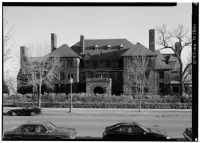
-

- Marley Zielike
240 Summit Ave, St Paul, MN 55102, USA
Hill bought three lots on Summit Avenue in 1882, during an era when wealthy citizens were scrambling to build fashionable homes in the neighborhood. The street offered a commanding view of downtown St. Paul and the Mississippi River area, making it a highly desirable location. The family previously lived in the Lowertown area in St. Paul, near Ninth and Canada streets. As new warehouses and railroad tracks crowded the Lowertown residential area, and as Hill's collection of paintings and sculpture overflowed the house, the Hill family thought it was desirable to move. Hill also realized that recent improvements in home technology, such as electric lighting, plumbing, ventilation, and fireproofing, could be incorporated into a new home. Moreover, since Hill was becoming a socially prominent person in the community, a new home would stand as a tribute to his status as the "Empire Builder". The house was designed by an East Coast architectural firm, Peabody, Stearns and Furber, at a time when other homes in the neighborhood were designed by local architects such as Clarence Johnston and Cass Gilbert. The house was designed in the Richardsonian Romanesque style, with a massive, rugged style featuring randomly sized blocks of stone, sturdy pillars, rounded arches, and a generally strong horizontal emphasis. Hill supervised the design and construction closely. As an example, when the Lewis Comfort Tiffany Company submitted designs for the stained glass windows, Hill replied that they were, "anything but what I want," and the job went to A.B. Cutter and Company of Boston. Later, in 1889, Hill fired the architects because they had overridden his orders to the stonecutters in Massachusetts, and hired the Boston firm of Irving and Casson to finish the project. The St. Paul Pioneer Press reviewed the house just before it was completed in 1891, saying: Solid, substantial, roomy, and comfortable is the new home of James J. Hill and family. ... There has been no attempt at display, no desire to flaunt an advertisement of wealth in the eyes of the world. Just a family home ... impressive, fine, even grand in the simplicity of design, but after all a St. Paul home.
240 Summit Ave, St Paul, MN 55102, USA
Hill bought three lots on Summit Avenue in 1882, during an era when wealthy citizens were scrambling to build fashionable homes in the neighborhood. The street offered a commanding view of downtown St. Paul and the Mississippi River area, making it a highly desirable location. The family previously lived in the Lowertown area in St. Paul, near Ninth and Canada streets. As new warehouses and railroad tracks crowded the Lowertown residential area, and as Hill's collection of paintings and sculpture overflowed the house, the Hill family thought it was desirable to move. Hill also realized that recent improvements in home technology, such as electric lighting, plumbing, ventilation, and fireproofing, could be incorporated into a new home. Moreover, since Hill was becoming a socially prominent person in the community, a new home would stand as a tribute to his status as the "Empire Builder". The house was designed by an East Coast architectural firm, Peabody, Stearns and Furber, at a time when other homes in the neighborhood were designed by local architects such as Clarence Johnston and Cass Gilbert. The house was designed in the Richardsonian Romanesque style, with a massive, rugged style featuring randomly sized blocks of stone, sturdy pillars, rounded arches, and a generally strong horizontal emphasis. Hill supervised the design and construction closely. As an example, when the Lewis Comfort Tiffany Company submitted designs for the stained glass windows, Hill replied that they were, "anything but what I want," and the job went to A.B. Cutter and Company of Boston. Later, in 1889, Hill fired the architects because they had overridden his orders to the stonecutters in Massachusetts, and hired the Boston firm of Irving and Casson to finish the project. The St. Paul Pioneer Press reviewed the house just before it was completed in 1891, saying: Solid, substantial, roomy, and comfortable is the new home of James J. Hill and family. ... There has been no attempt at display, no desire to flaunt an advertisement of wealth in the eyes of the world. Just a family home ... impressive, fine, even grand in the simplicity of design, but after all a St. Paul home.
240 Summit Ave, St Paul, MN 55102, USA
Hill bought three lots on Summit Avenue in 1882, during an era when wealthy citizens were scrambling to build fashionable homes in the neighborhood. The street offered a commanding view of downtown St. Paul and the Mississippi River area, making it a highly desirable location. The family previously lived in the Lowertown area in St. Paul, near Ninth and Canada streets. As new warehouses and railroad tracks crowded the Lowertown residential area, and as Hill's collection of paintings and sculpture overflowed the house, the Hill family thought it was desirable to move. Hill also realized that recent improvements in home technology, such as electric lighting, plumbing, ventilation, and fireproofing, could be incorporated into a new home. Moreover, since Hill was becoming a socially prominent person in the community, a new home would stand as a tribute to his status as the "Empire Builder".The house was designed by an East Coast architectural firm, Peabody, Stearns and Furber, at a time when other homes in the neighborhood were designed by local architects such as Clarence Johnston and Cass Gilbert. The house was designed in the Richardsonian Romanesque style, with a massive, rugged style featuring randomly sized blocks of stone, sturdy pillars, rounded arches, and a generally strong horizontal emphasis. Hill supervised the design and construction closely. As an example, when the Lewis Comfort Tiffany Company submitted designs for the stained glass windows, Hill replied that they were, "anything but what I want," and the job went to A.B. Cutter and Company of Boston. Later, in 1889, Hill fired the architects because they had overridden his orders to the stonecutters in Massachusetts, and hired the Boston firm of Irving and Casson to finish the project. The St. Paul Pioneer Press reviewed the house just before it was completed in 1891, saying:
Solid, substantial, roomy, and comfortable is the new home of James J. Hill and family. ... There has been no attempt at display, no desire to flaunt an advertisement of wealth in the eyes of the world. Just a family home ... impressive, fine, even grand in the simplicity of design, but after all a St. Paul home.
Posted Date
May 20, 2022
Historical Record Date
Jun 01, 1985
Source Name
Library of Congress
Source Website
Delete Story
Are you sure you want to delete this story?
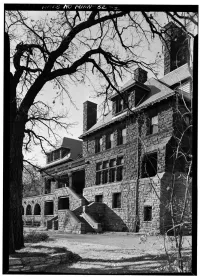
James J. Hill House, 240 Summit Ave Saint Paul, Ramsey County, MN
One of the show places of St. Paul at the turn of the twentieth century.
James J. Hill House, 240 Summit Ave Saint Paul, Ramsey County, MN
One of the show places of St. Paul at the turn of the twentieth century.Posted Date
Sep 27, 2021
Source Name
Library of Congress
Source Website
Delete Story
Are you sure you want to delete this story?
James J. Hill House, Gatehouse, 240 Summit Ave Saint Paul, Ramsey County, MN
HABS MN-52-APosted Date
Sep 27, 2021
Source Name
Library of Congress
Source Website
Delete Story
Are you sure you want to delete this story?



